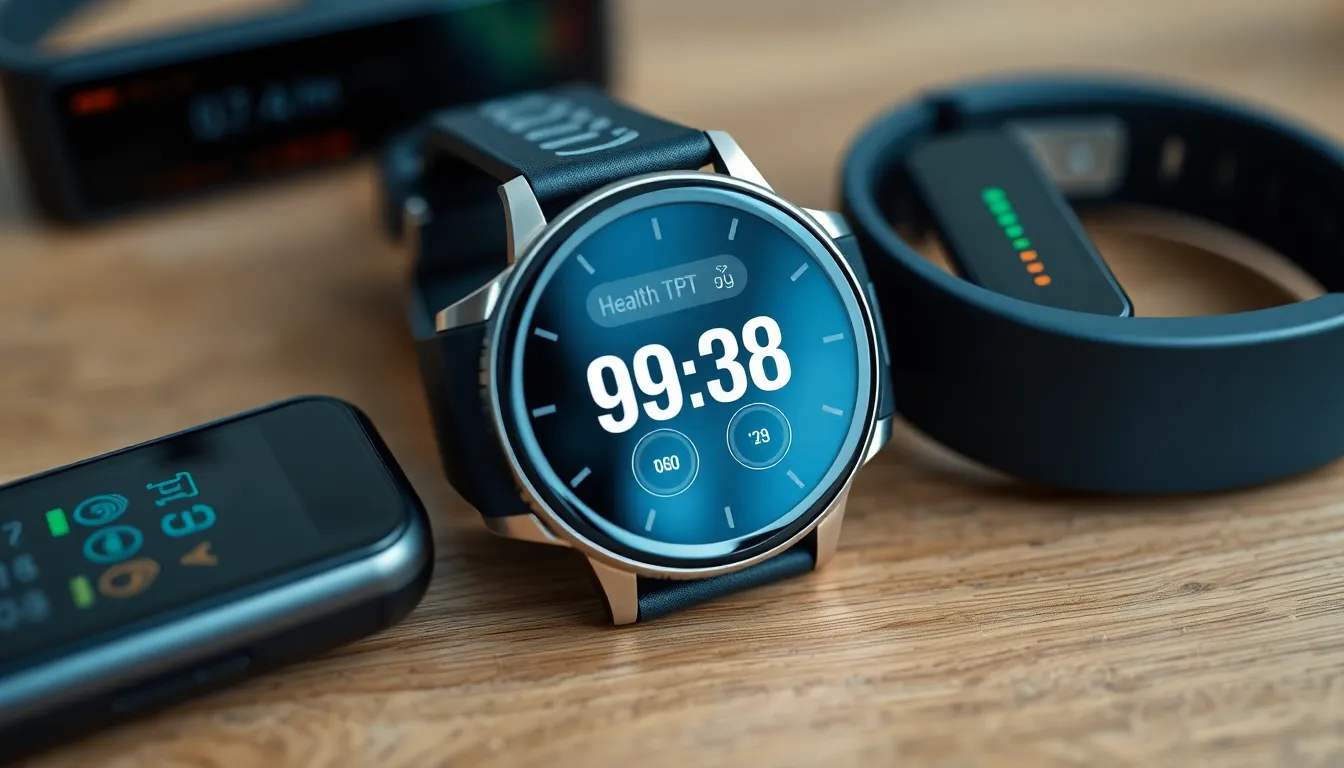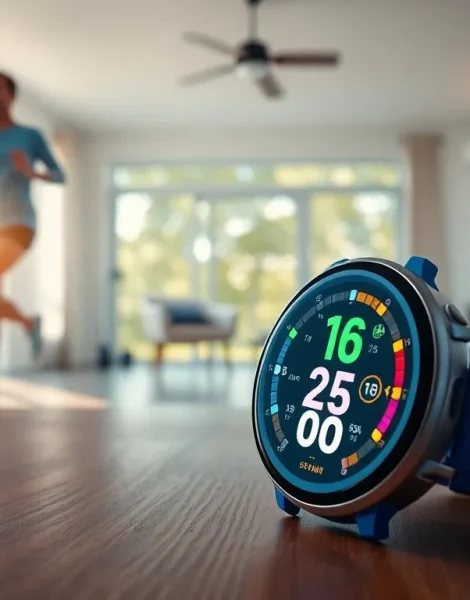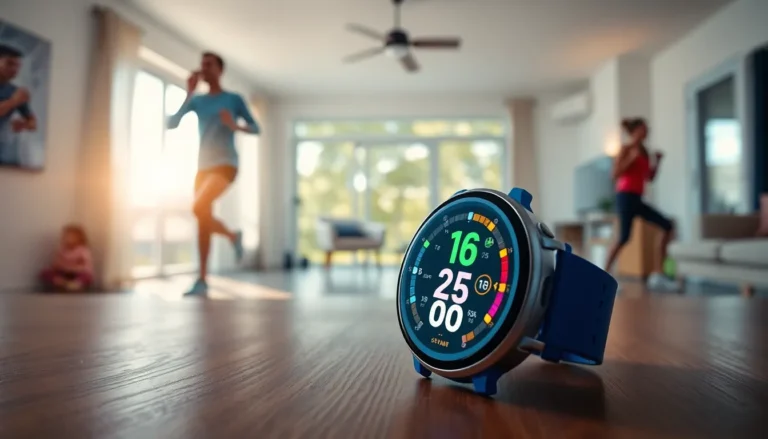In a world where smartwatches and fitness trackers have become as essential as morning coffee, the struggle for battery life is real. Imagine gearing up for a day of adventure, only to have your trusty wearable fizzle out faster than a toddler’s attention span. It’s a situation that leaves many feeling like they’ve been left hanging—literally.
Wearable technology promises convenience and connectivity, but when the battery’s dead, it’s like having a smartphone with no signal. Let’s dive into the fascinating world of wearable battery life, exploring tips, tricks, and the latest innovations that keep these gadgets powered up and ready for action. After all, no one wants to be that person checking their watch only to find it’s gone to the great tech graveyard in the sky.
Table of Contents
ToggleOverview of Wearable Battery Life
Battery life plays a crucial role in the functionality of wearables like smartwatches and fitness trackers. Users expect these devices to offer longevity and reliability, minimizing instances of unexpected power loss.
Importance of Battery Life in Wearables
Battery life holds significant importance in wearables, directly impacting user experience. Users rely on consistent performance for tracking fitness metrics or receiving notifications. Short battery life causes inconvenience and disrupts daily routines. Enhanced battery life allows users to engage with their devices without frequent charging interruptions. Brands that prioritize battery optimization often see increased satisfaction and loyalty from customers.
Factors Affecting Battery Life
Multiple factors influence the battery life of wearable devices. Display type and size affect energy consumption, with larger or brighter screens requiring more power. Additionally, connectivity features like Bluetooth and GPS can drain batteries quickly during prolonged usage. The frequency of app usage and background processes also contribute to diminished battery performance. Lastly, temperature conditions impact battery longevity, with extreme heat or cold affecting efficiency. Understanding these factors helps users manage expectations and optimize usage of their devices.
Types of Wearable Devices

Wearable devices come in various forms, each with unique features and battery life considerations. Smartwatches, fitness trackers, and health monitors represent the main categories.
Smartwatches
Smartwatches offer versatile functionalities, including notifications and app management. Battery life typically ranges from one to three days, depending on usage and features. High-resolution displays and continuous connectivity with smartphones significantly impact power consumption. Users can adopt power-saving modes to extend battery longevity on days with heavier use. Brands such as Apple and Samsung provide options with varying battery capacities, catering to different user needs.
Fitness Trackers
Fitness trackers focus on health metrics like steps and heart rate. Many models boast battery life spanning from four days to several weeks, given their limited display features. Users benefit from basic functionality without the constant connectivity of smartwatches. Some devices include options to sync data periodically, thereby conserving power. The lighter weight and streamlined features often make these trackers ideal for daily wear.
Health Monitors
Health monitors cater to individuals prioritizing specific health metrics, such as blood pressure or glucose levels. Battery life can differ widely, typically lasting from a few days to weeks. Many devices integrate continuous monitoring options, impacting power usage. Users should consider models with rechargeable batteries versus disposable ones for convenience. These devices serve as valuable tools for managing chronic conditions while providing the essential data users require.
Battery Technologies in Wearables
Battery technology plays a significant role in the performance of wearable devices. Understanding different battery types helps users maximize their device experience.
Lithium-Ion Batteries
Lithium-ion batteries dominate wearable technology due to their high energy density and lightweight design. Smartwatches and fitness trackers commonly utilize these batteries, offering battery life ranging from one day to several weeks. Their rechargeability provides convenience, making them a favored choice among manufacturers. Enhanced charging cycles allow users to expect a longer lifespan from these batteries, contributing to overall device performance. On average, lithium-ion batteries can maintain about 80% of their capacity after 300-500 charge cycles.
Solar Power Options
Solar power options are gaining popularity in wearables for providing additional energy. Small solar cells incorporated into devices can extend battery life by harnessing sunlight. Users benefit from this technology during outdoor activities, potentially reducing dependence on conventional charging methods. This eco-friendly approach aligns with growing sustainability trends. Interestingly, some advanced models combine solar power with traditional batteries, optimizing energy utilization and enhancing performance.
Energy Harvesting Techniques
Energy harvesting techniques provide innovative solutions for wearable battery life. These methods capture energy from everyday movements, such as walking or body heat, converting it into usable power. Systems employing kinetic energy harvesting can prolong device functionality without frequent charging. Various wearables, including smartwatches and health monitors, now feature these integrated technologies. Consequently, energy harvesting reduces reliance on external energy sources and aids in maintaining operational efficiency. Flexibility in design allows manufacturers to create a range of devices catering to diverse user needs.
Strategies for Improving Wearable Battery Life
Users can implement several strategies to enhance wearable battery life. Understanding these approaches facilitates a more reliable experience with wearable technology.
Power Management Software
Power management software plays a critical role in extending battery life. This software dynamically adjusts settings based on usage patterns, minimizing energy consumption. Features like adaptive brightness and screen timeout settings conserve power. Regular software updates often introduce efficiency improvements, so keeping devices updated remains essential. Many wearables now feature energy-efficient processors, optimizing power during various tasks.
Sleep Modes and Optimizations
Wearables equipped with sleep modes can significantly save battery life. These modes limit background activity during periods of inactivity. Engaging sleep tracking helps automatically activate this feature, reducing energy use while maintaining necessary monitoring functions. Some devices allow for customizable sleep settings, meaning users can tailor optimizations based on their sleeping habits. Utilizing this feature ensures that battery life remains longer during nighttime hours, preventing disruptions.
User Habits and Settings
User habits and settings greatly influence battery longevity. Disabling unused features like GPS or continuous heart rate monitoring conserves energy. Customizing notification settings helps reduce frequent vibrations or screen wake-ups, thereby saving battery. Regularly charging devices overnight ensures optimal performance, but avoiding overcharging is also crucial. Users can track battery usage through device settings, identifying which apps or functions drain power the most.
Future of Wearable Battery Life
The evolution of wearable battery life continues to capture attention. Innovations in technology promise to enhance performance significantly.
Emerging Technologies
Battery life improvements often stem from advanced technologies. Solid-state batteries stand out for their energy density and safety, offering a longer lifespan than traditional lithium-ion options. Additionally, researchers are exploring graphene batteries, which could lead to lighter, faster-charging wearables. Another promising area is nanotechnology, enabling the creation of smaller, more efficient energy sources that align with compact designs. Lastly, the integration of energy harvesting techniques, like kinetic energy conversion, further extends the possibility of off-grid charging for wearables.
Trends and Innovations in Battery Life
Several trends are reshaping the battery life landscape. The shift towards energy-efficient displays, such as OLED technology, contributes to longer battery durations. Wearable software also plays a pivotal role, with manufacturers focusing on optimizing power management capabilities. Smart algorithms analyze user behavior, allowing devices to adapt usage patterns to conserve battery. Furthermore, the growing demand for solar-powered wearables demonstrates the willingness of users to explore sustainable alternatives. Collectively, these innovations aim to reduce downtime and enhance the overall user experience.
Battery life remains a critical aspect of wearable technology that directly impacts user experience. As devices become more advanced and feature-rich, understanding how to maximize battery longevity is essential. Users can employ various strategies to enhance performance and ensure their wearables remain functional throughout the day.
Emerging technologies offer exciting possibilities for the future of battery life in wearables. Innovations like solid-state batteries and energy harvesting techniques promise to reduce charging frequency and enhance overall efficiency. As the market evolves, staying informed about these advancements will empower users to make the most of their devices. Ultimately, a focus on battery management and the adoption of new technologies will lead to a more seamless and enjoyable wearable experience.









